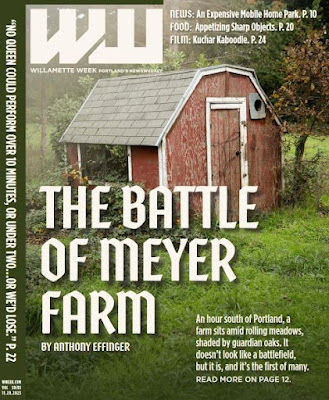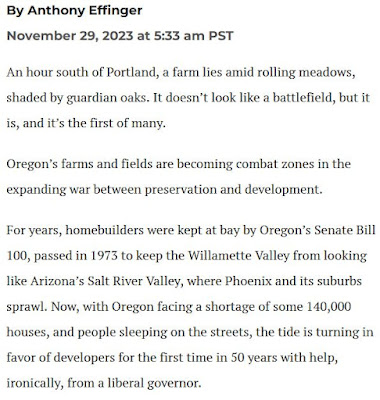Willamette Week's cover story on the Meyer Farm has occasioned a bit of comment this week. But it's really a weird piece, though, and perhaps this is a reason comment has been a little muted.
 |
| The cover story this week |
Structurally, it's chimerical, half a policy piece on emerging problems in housing reform, and half a melodrama on the Meyer family. It would have been much stronger to stick with one of them.
It starts by leaning heavily into the idea and romance of a "farm."
 |
| The intro is crucially misleading |
This introduction sets up the notion of a working farm outside the Urban Growth Boundary: "[A] farm lies amid rolling meadows, shaded by guardian oaks" and invoking Senate Bill 100 paint a definite picture of a rural setting.
 |
| Are we sure it's "prime farmland"? |
But that is not in fact the situation and context. The Meyer farm is an undeveloped parcel, not a working farm, surrounded by development, leap-frogged decades ago in ways our land use laws were intended to discourage. From Trader Joe's south to I-5 and the city limits is about 3 miles.
The rhetoric of "a sneak preview of the fights that can be expected" suggests the policy piece really should have prevailed, and it leads into a subtext of Portland criticism of Governor Kotek's focus on housing. The piece expresses a kind of eco-NIMBY sentiment, "houses vs. trees." It even invokes vintage red scare sentiment, saying "Shortly after becoming governor, Kotek formed the Soviet-sounding Housing Production Advisory Council."*
 |
| It's weirdly hostile to Gov. Kotek |
The piece did clarify something that had been obscure.
 |
| A new remand on the Meyer Farm? |
Back in late October LUBA published a mysterious final order on the Meyer Farm, "the parties request that the decision challenged in this appeal be remanded."
Why would that be?
The article has a likely explanation.
 |
| Explaining the LUBA remand? |
In October "to avoid a property line fight...[the developer agreed] to buy all of the Meyer property."
Presumably the mutually agreeable remand followed this purchase agreement.
Two helpful things were in the piece.
It seemed to suggest that the housing reform law might need some refinement so that large detached houses might be excluded from some of the benefit and incentives. If the goal is to produce more smaller housing in more walkable and more affordable configurations, this proposed development, well located for transit and near grocery stores, fails to take advantage of possibilities for row houses, smallplexes, or other more urban configurations. Which would have the benefit too of allowing for better tree preservation.
[Then Speaker Kotek's] bill, now a law, said that “a county may not deny an application for a housing development located within the urban growth boundary if the development complies with clear and objective standards, including but not limited to clear and objective design standards contained in the county comprehensive plan or land use regulations.”
It also redefined the concept of “needed housing” as “all housing [types] on land zoned for residential use or mixed residential and commercial use that is determined to meet the need shown for housing within an urban growth boundary at [particular] price ranges and rent levels.”
The word “all” got added to Kotek’s House version, and that one small word opened up big opportunities for builders of tract homes, says Richter, the land use lawyer.
Before, developers of single-family subdivisions like Kehoe could get stuck in a thicket of regulations governing everything from the opacity of hedges to the steepness of berms. Now, they can claim exemptions from any rule that isn’t specified to the foot or inch, because big tract homes are “needed housing,” according to the state, and their production must be expedited.
If there's a way to craft a fairly surgical exclusion for larger single detached houses, that might be a very useful refinement and correction. This cannot be the kind of development our housing reforms were aiming for.
 |
| This overlay is helpful |
The map overlay in the piece was also helpful, but also undercuts a little the "houses vs. trees" focus. Two groves look substantially to remain.
A better piece would be more realistic about the location of the parcel well inside the UGB and Salem city limits, and right by a Trader Joe's. It would talk about missed opportunities for a more modern urbanism. If it was going to continue with a focus on Salem, it would balance difficulties at the Meyer site with a discussion of more successful projects like the Nishioka building, the new development at the former Nordstrom site, and the proposed development at the old City Hall site. Eliminating parking requirements has been key to all of them. Speaker/Governor Kotek's reforms, and a few things Salem initiated on its own, have been helpful with these. The piece could talk also about struggle to realize the full vision at the former Fairview, which one of the Meyer family helped master plan. The lack of middle housing at Fairview suggests a demand side problem: People still want lawn and driveway housing. Maybe lenders, too. In order to make the course-correction, incentives for middle housing and more urban forms likely still need stronger support.
- "Aesthetics of Sustainability and the still-Missing Middle at Fairview"
- "Village Center Concept mostly Abandoned at Fairview"
- "Block 50 Announcement Suggests Learning from Fairview Discussion 20 Years Ago"
A melodrama about the Meyer family is juicier reading, but an analysis of early results in housing reform is far more important. This was a missed opportunity.
* We joke about communist brutalism here with regard to City Hall, but as Seth Cotlar points out in his most recent note, "Those "funny" fluoride fighters were, frankly, fanners of fascism's flames," the rhetoric of red scare was harnessed to more sinister ends:
[G]ood old Dr. Bronner, I learned recently, was an influential voice in the 1950s era antisemitic “fluoride is Communism” movement, despite the fact that he was a Jewish refugee whose parents had been murdered in the Holocaust....Anti-fluoridation, in other words, amplified a form of politics I would describe as “participatory anti-democracy.” It fired up a fairly small community of people to aggressively use their voices, their bodies, and their votes to gum up the works of democratic self-governance—to create innumerable local firestorms comprised of propagandistic disinformation and baseless conspiracy theories that needlessly absorbed an inordinate amount of public attention and, in many cases, generated enough public cynicism about government, the media, and science to short circuit the implementation of inexpensive and beneficial public policies.Heading into November 2024, journalists should be more aware of the stakes and refrain from classic red scare tropes.


No comments:
Post a Comment